Investigating Synoptic Influences on Tropospheric Volcanic Ash Dispersion from the 2015 Calbuco Eruption Using WRF-Chem Simulations and Satellite Data
Abstract
1. Introduction
2. Materials and Methods
2.1. Description of the Event
2.2. Synoptic Analysis During the Event
2.3. Orography Influence
2.4. WRF-Chem Model: Setup for Volcanic Emissions
2.5. Description of the Event by AOD from AERDB OMPS-SNPP
2.6. Description of the Event by Split Windows Imagery from VIIRS
3. Results and Discussion
3.1. Comparison with Satellite Data
3.1.1. AERDB_D3_VIIRS
3.1.2. OMI/OMPS
4. Conclusions
- From a meteorology perspective, the WRF-ARW core of the WRF-Chem model successfully reproduced the synoptic patterns responsible for ash transport. The fine ash from the two massive eruptions of Mount Calbuco contaminated the airspace around the volcano within a radius of about 4000 km in a few days. This is a very important aspect that needs to be considered; in fact, the complexity of the problem requires an integrated approach consisting of an online coupling between meteorology and aerosols.
- The comparison between model and AOD utilizing the experimental data allowed us to select the optimal granulometry distribution (S1), which may be important in subsequent studies.
- Our comparison between the SO2 dispersion maps simulated by the model and the OMI-OMPS retrievals report good agreement, likely with a slight overestimation of the simulated concentration of SO2. This discrepancy is likely caused by an overestimation of the SO2 emission rate.
Author Contributions
Funding
Data Availability Statement
Acknowledgments
Conflicts of Interest
Appendix A
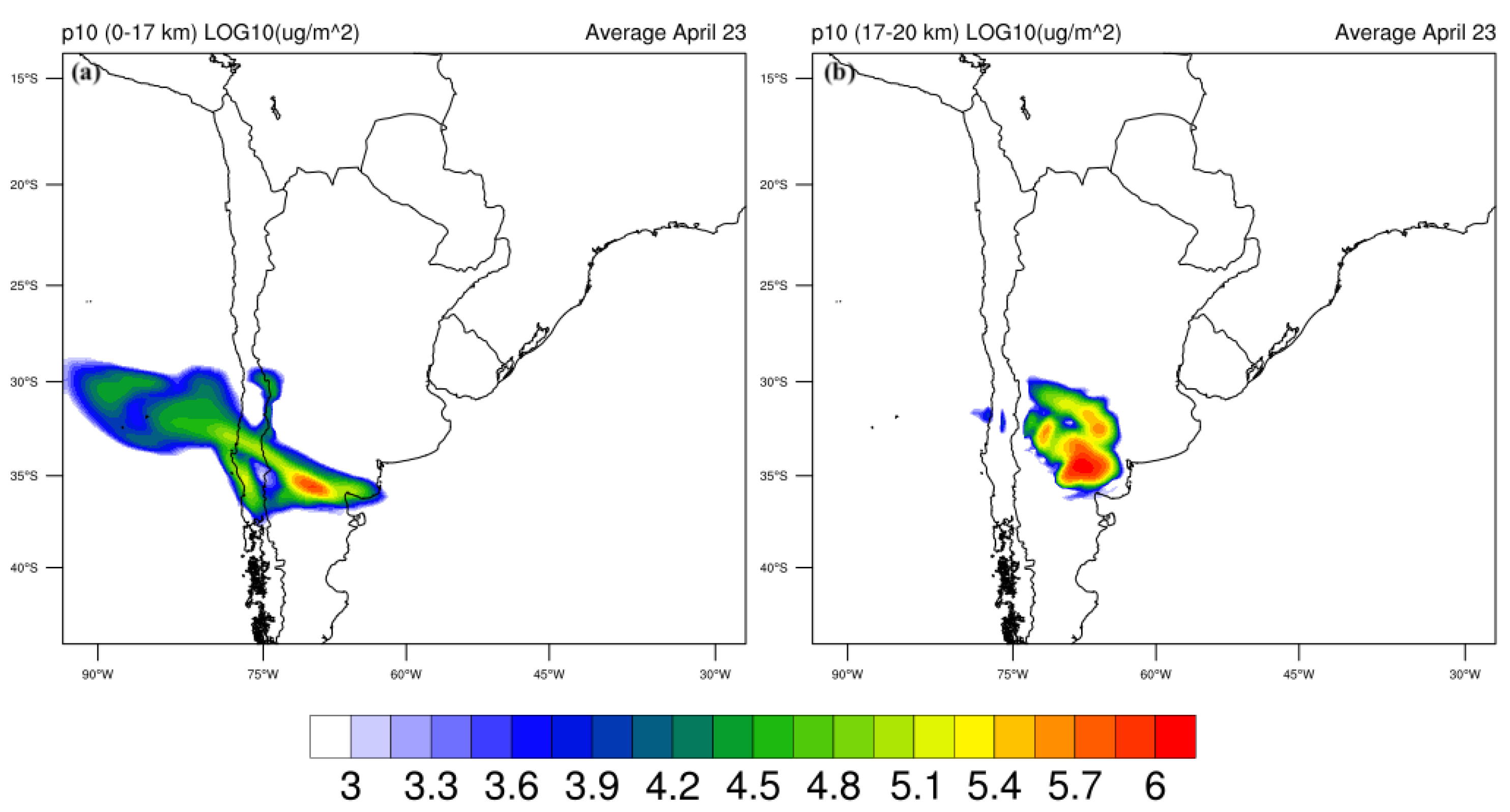
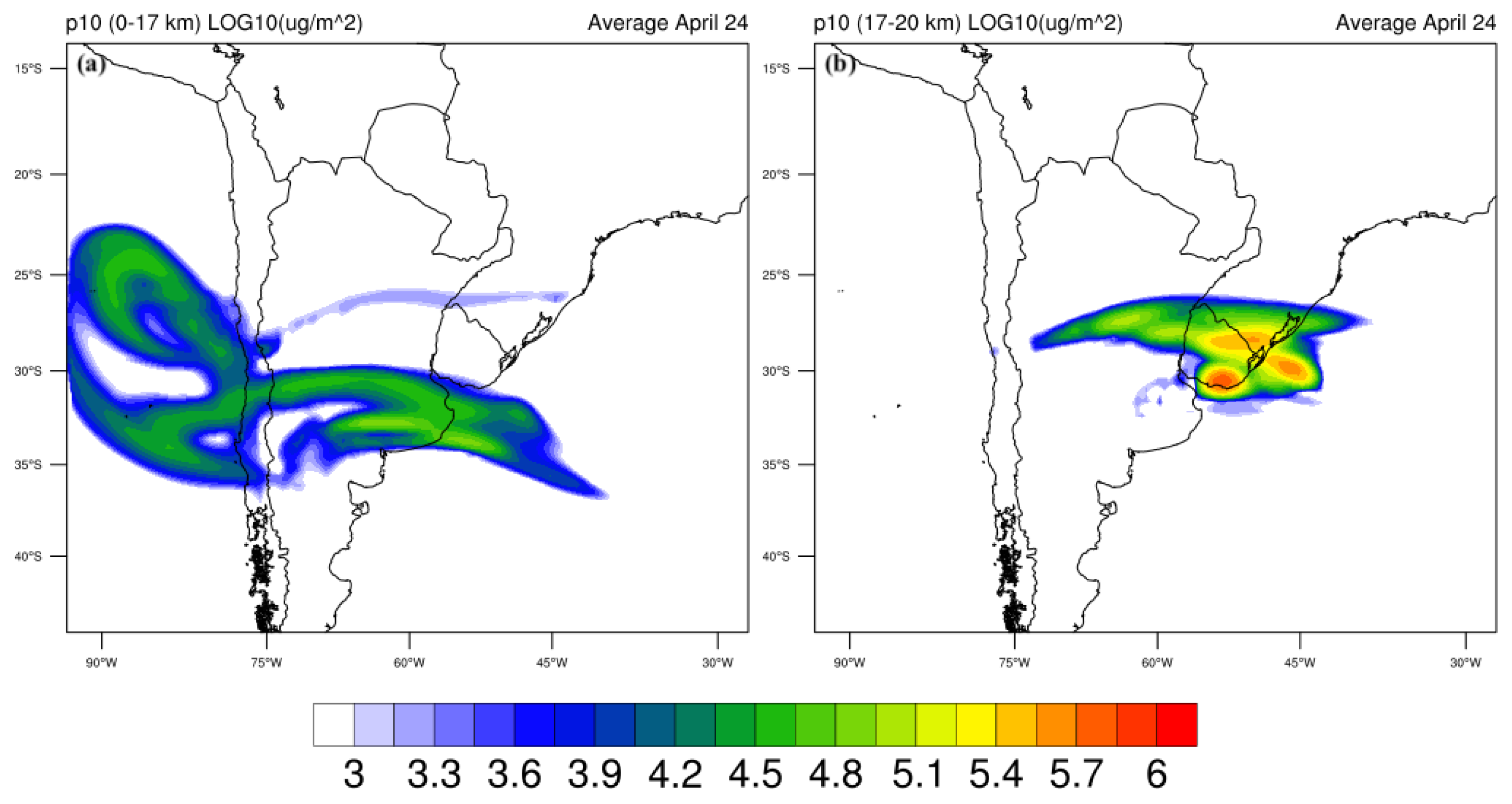


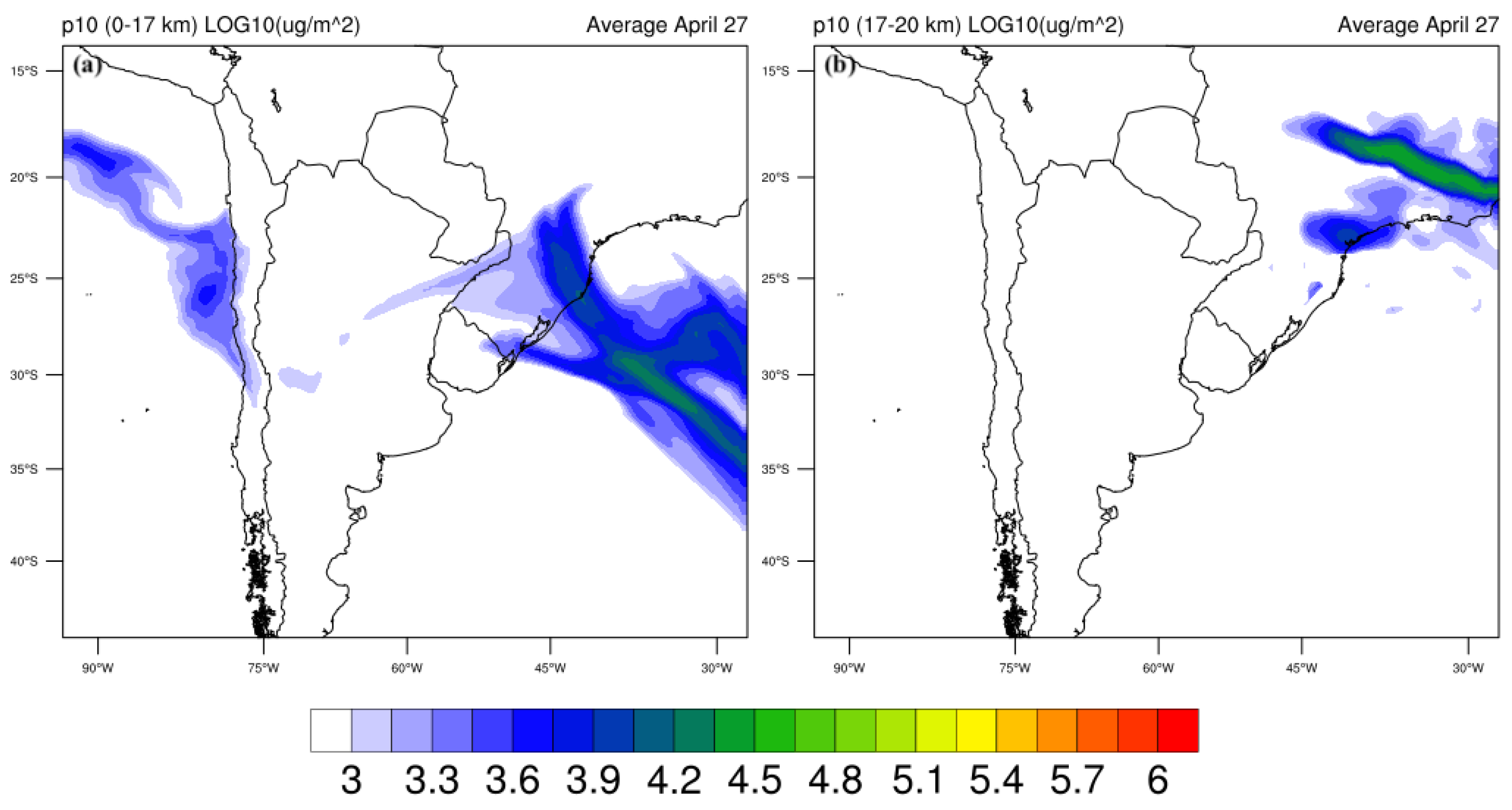
Appendix B
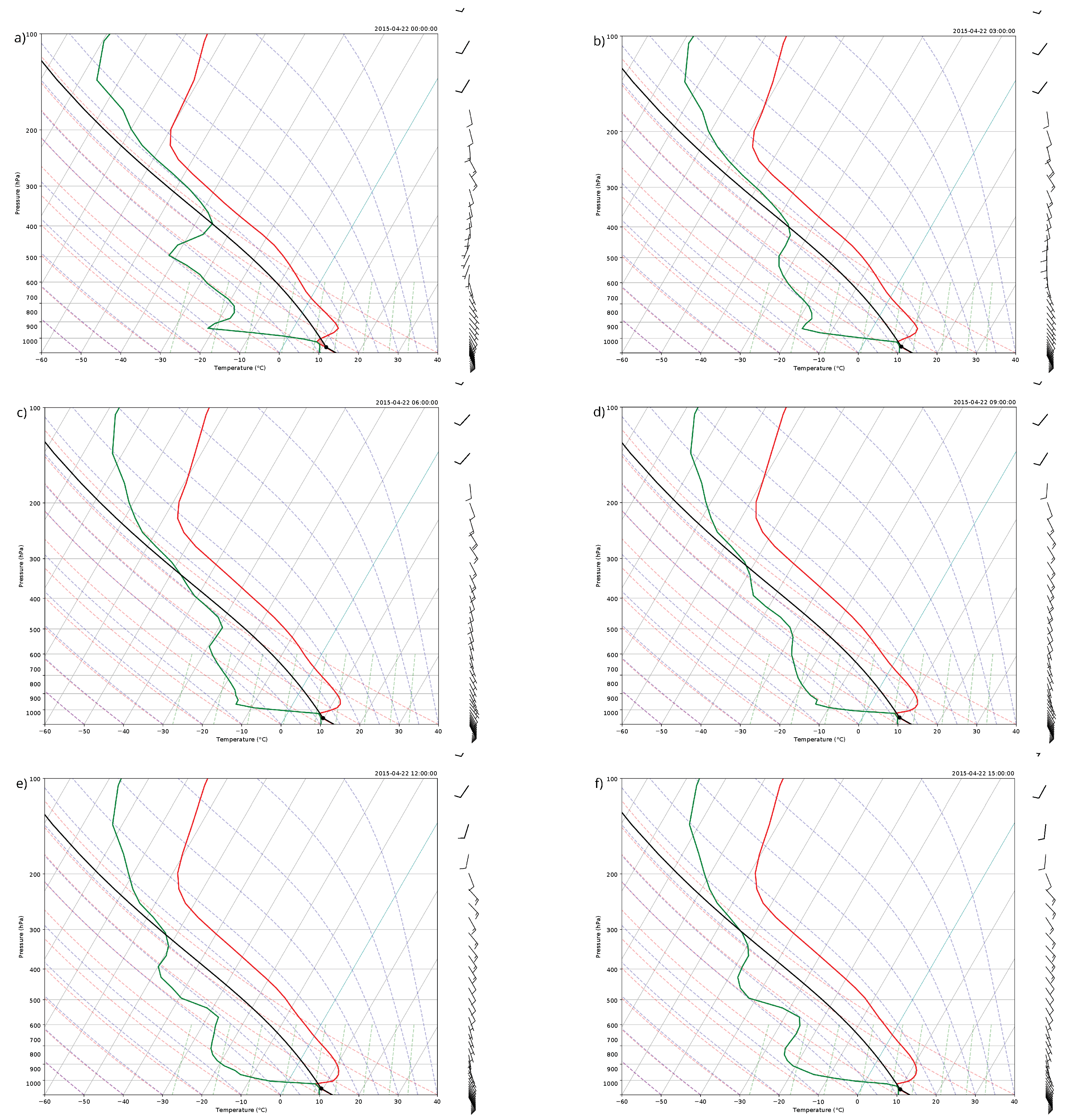
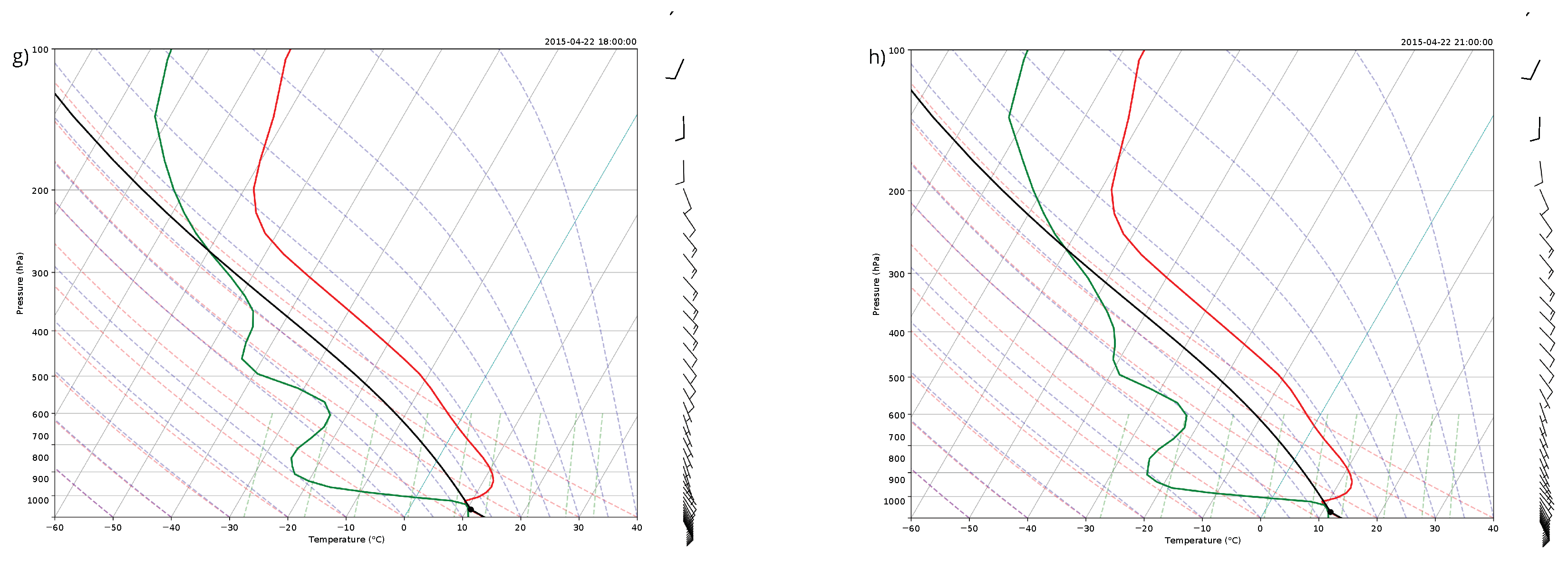
References
- Ramaswamy, V.; Collins, W.; Haywood, J.; Lean, J.; Mahowald, N.; Myhre, G.; Naik, V.; Shine, K.P.; Soden, B.; Stenchikov, G.; et al. Radiative forcing of climate: The historical evolution of the radiative forcing concept, the forcing agents and their quantification, and applications. Meteorol. Monogr. 2019, 59, 14.1–14.101. [Google Scholar] [CrossRef]
- Charlson, R.J.; Schwartz, S.; Hales, J.; Cess, R.D.; Coakley, J., Jr.; Hansen, J.; Hofmann, D. Climate forcing by anthropogenic aerosols. Science 1992, 255, 423–430. [Google Scholar] [CrossRef] [PubMed]
- Twomey, S. The influence of pollution on the shortwave albedo of clouds. J. Atmos. Sci. 1977, 34, 1149–1152. [Google Scholar] [CrossRef]
- Textor, C.; Graf, H.F.; Timmreck, C.; Robock, A. Emissions from volcanoes. In Emissions of Atmospheric Trace Compounds; Springer: Berlin/Heidelberg, Germany, 2004; pp. 269–303. [Google Scholar] [CrossRef]
- Arghavani, S.; Rose, C.; Banson, S.; Lupascu, A.; Gouhier, M.; Sellegri, K.; Planche, C. The effect of using a new parameterization of nucleation in the WRF-Chem model on new particle formation in a passive volcanic plume. Atmosphere 2021, 13, 15. [Google Scholar] [CrossRef]
- Tsigaridis, K.; Krol, M.; Dentener, F.; Balkanski, Y.; Lathiere, J.; Metzger, S.; Hauglustaine, D.; Kanakidou, M. Change in global aerosol composition since preindustrial times. Atmos. Chem. Phys. 2006, 6, 5143–5162. [Google Scholar] [CrossRef]
- McCormick, M.P.; Thomason, L.W.; Trepte, C.R. Atmospheric effects of the Mt Pinatubo eruption. Nature 1995, 373, 399–404. [Google Scholar] [CrossRef]
- Sellitto, P.; Podglajen, A.; Belhadji, R.; Boichu, M.; Carboni, E.; Cuesta, J.; Duchamp, C.; Kloss, C.; Siddans, R.; Bègue, N.; et al. The unexpected radiative impact of the Hunga Tonga eruption of 15 January 2022. Commun. Earth Environ. 2022, 3, 288. [Google Scholar] [CrossRef]
- Stern, C.R.; Moreno, H.; López-Escobar, L.; Clavero, J.E.; Lara, L.E.; Naranjo, J.A.; Parada, M.A.; Skewes, M.A. Chilean volcanoes. Geol. Soc. Lond. 2007. [Google Scholar] [CrossRef]
- Newhall, C.G.; Self, S. The volcanic explosivity index (VEI) an estimate of explosive magnitude for historical volcanism. J. Geophys. Res. Ocean. 1982, 87, 1231–1238. [Google Scholar] [CrossRef]
- González-Ferrán, O. Volcanes de Chile. Instituto Geográfico Militar. Santiago 1995, 635. Available online: https://books.google.fr/books?id=m2hdAAAAMAAJ (accessed on 1 October 2024).
- Petit-Breuilh, M. Cronologia Eruptiva Historica de los Volcanes Osorno y Calbuco, Andes del Sur (41°–41°30’s); Servicio Nacional de Geología y Minería: Santiago, Chile, 1999.
- Daga, R.; Guevara, S.R.; Poire, D.G.; Arribére, M. Characterization of tephras dispersed by the recent eruptions of volcanoes Calbuco (1961), Chaitén (2008) and Cordón Caulle Complex (1960 and 2011), in Northern Patagonia. J. S. Am. Earth Sci. 2014, 49, 1–14. [Google Scholar] [CrossRef]
- Bègue, N.; Vignelles, D.; Berthet, G.; Portafaix, T.; Payen, G.; Jégou, F.; Bencherif, H.; Jumelet, J.; Vernier, J.P.; Lurton, T.; et al. Long-range transport of stratospheric aerosols in the Southern Hemisphere following the 2015 Calbuco eruption. Atmos. Chem. Phys. 2017, 17, 15019–15036. [Google Scholar] [CrossRef]
- JS Lopes, F.; Silva, J.J.; Antuna Marrero, J.C.; Taha, G.; Landulfo, E. Synergetic aerosol layer observation after the 2015 calbuco volcanic eruption event. Remote Sens. 2019, 11, 195. [Google Scholar] [CrossRef]
- Van Eaton, A.R.; Amigo, Á.; Bertin, D.; Mastin, L.G.; Giacosa, R.E.; González, J.; Valderrama, O.; Fontijn, K.; Behnke, S.A. Volcanic lightning and plume behavior reveal evolving hazards during the April 2015 eruption of Calbuco volcano, Chile. Geophys. Res. Lett. 2016, 43, 3563–3571. [Google Scholar] [CrossRef]
- Romero, J.; Morgavi, D.; Arzilli, F.; Daga, R.; Caselli, A.; Reckziegel, F.; Viramonte, J.; Díaz-Alvarado, J.; Polacci, M.; Burton, M.; et al. Eruption dynamics of the 22–23 April 2015 Calbuco Volcano (Southern Chile): Analyses of tephra fall deposits. J. Volcanol. Geotherm. Res. 2016, 317, 15–29. [Google Scholar] [CrossRef]
- Marzano, F.S.; Corradini, S.; Mereu, L.; Kylling, A.; Montopoli, M.; Cimini, D.; Merucci, L.; Stelitano, D. Multisatellite multisensor observations of a Sub-Plinian volcanic eruption: The 2015 Calbuco explosive event in Chile. IEEE Trans. Geosci. Remote Sens. 2018, 56, 2597–2612. [Google Scholar] [CrossRef]
- Mastin, L.G.; Van Eaton, A.R. Comparing simulations of umbrella-cloud growth and ash transport with observations from Pinatubo, Kelud, and Calbuco volcanoes. Atmosphere 2020, 11, 1038. [Google Scholar] [CrossRef]
- Schwaiger, H.F.; Denlinger, R.P.; Mastin, L.G. Ash3d: A finite-volume, conservative numerical model for ash transport and tephra deposition. J. Geophys. Res. Solid Earth 2012, 117. [Google Scholar] [CrossRef]
- Castorina, G.; Semprebello, A.; Gattuso, A.; Salerno, G.; Sellitto, P.; Italiano, F.; Rizza, U. Modelling Paroxysmal and Mild-Strombolian Eruptive Plumes at Stromboli and Mt. Etna on 28 August 2019. Remote Sens. 2023, 15, 5727. [Google Scholar] [CrossRef]
- Stuefer, M.; Freitas, S.; Grell, G.; Webley, P.; Peckham, S.; McKeen, S.; Egan, S. Inclusion of ash and SO2 emissions from volcanic eruptions in WRF-Chem: Development and some applications. Geosci. Model Dev. 2013, 6, 457–468. [Google Scholar] [CrossRef]
- Stenchikov, G.; Ukhov, A.; Osipov, S. Modeling of Instantaneous and Adjusted Radiative Forcing of the 2022 Hunga Volcano Explosion. In Proceedings of the EGU General Assembly 2024, Vienna, Austria, 14–19 April 2024. [Google Scholar] [CrossRef]
- Fast, J.D.; Gustafson, W.I., Jr.; Easter, R.C.; Zaveri, R.A.; Barnard, J.C.; Chapman, E.G.; Grell, G.A.; Peckham, S.E. Evolution of ozone, particulates, and aerosol direct radiative forcing in the vicinity of Houston using a fully coupled meteorology-chemistry-aerosol model. J. Geophys. Res. Atmos. 2006, 111. [Google Scholar] [CrossRef]
- Stenchikov, G.; Lahoti, N.; Diner, D.J.; Kahn, R.; Lioy, P.J.; Georgopoulos, P.G. Multiscale plume transport from the collapse of the World Trade Center on September 11, 2001. Environ. Fluid Mech. 2006, 6, 425–450. [Google Scholar] [CrossRef]
- Seluchi, M.E.; Marengo, J.A. Tropical–midlatitude exchange of air masses during summer and winter in South America: Climatic aspects and examples of intense events. Int. J. Climatol. A J. R. Meteorol. Soc. 2000, 20, 1167–1190. [Google Scholar] [CrossRef]
- Marengo, J.A.; Seluchi, M.E. Tropical mid-latitude exchange of air masses in South America. Part I: Some climatic aspects. In Proceedings of the Trabajo presentado en el VIII Congreso Latinoamericano e Ibérico de Meteorología y X Congresso Brasileiro de Meteorologia, Brasilia, Brasil, 20 January 1998. [Google Scholar]
- Gan, M.A.; Rao, V.B. The influence of the Andes Cordillera on transient disturbances. Mon. Weather Rev. 1994, 122, 1141–1157. [Google Scholar] [CrossRef]
- Seluchi, M.E.; Garreaud, R.; Norte, F.A.; Saulo, A.C. Influence of the subtropical Andes on baroclinic disturbances: A cold front case study. Mon. Weather Rev. 2006, 134, 3317–3335. [Google Scholar] [CrossRef]
- Satyamurty, P.; Dos Santos, R.P.; Lems, M.A.M. On the stationary trough generated by the Andes. Mon. Weather Rev. 1980, 108, 510–520. [Google Scholar] [CrossRef]
- Ivy, D.J.; Solomon, S.; Kinnison, D.; Mills, M.J.; Schmidt, A.; Neely III, R.R. The influence of the Calbuco eruption on the 2015 Antarctic ozone hole in a fully coupled chemistry-climate model. Geophys. Res. Lett. 2017, 44, 2556–2561. [Google Scholar] [CrossRef]
- Phillips, N.A. The general circulation of the atmosphere: A numerical experiment. Q. J. R. Meteorol. Soc. 1956, 82, 123–164. [Google Scholar] [CrossRef]
- Pinheiro, H.R.; Hodges, K.I.; Gan, M.A.; Ferreira, N.J. A new perspective of the climatological features of upper-level cut-off lows in the Southern Hemisphere. Clim. Dyn. 2017, 48, 541–559. [Google Scholar] [CrossRef]
- Hakim, G.J.; Uccellini, L.W. Diagnosing coupled jet-streak circulations for a northern plains snow band from the operational nested-grid model. Weather Forecast. 1992, 7, 26–48. [Google Scholar] [CrossRef]
- Uccellini, L.W.; Kocin, P.J. The interaction of jet streak circulations during heavy snow events along the east coast of the United States. Weather Forecast. 1987, 2, 289–308. [Google Scholar] [CrossRef]
- Arzilli, F.; Morgavi, D.; Petrelli, M.; Polacci, M.; Burton, M.; Di Genova, D.; Spina, L.; La Spina, G.; Hartley, M.E.; Romero, J.E.; et al. The unexpected explosive sub-Plinian eruption of Calbuco volcano (22–23 April 2015; southern Chile): Triggering mechanism implications. J. Volcanol. Geotherm. Res. 2019, 378, 35–50. [Google Scholar] [CrossRef]
- Seluchi, M.E.; Norte, F.A.; Satyamurty, P.; Chou, S.C. Analysis of three situations of the foehn effect over the Andes (zonda wind) using the Eta–CPTEC regional model. Weather Forecast. 2003, 18, 481–501. [Google Scholar] [CrossRef]
- Grell, G.A.; Peckham, S.E.; Schmitz, R.; McKeen, S.A.; Frost, G.; Skamarock, W.C.; Eder, B. Fully coupled “online” chemistry within the WRF model. Atmos. Environ. 2005, 39, 6957–6975. [Google Scholar] [CrossRef]
- Chin, M.; Rood, R.B.; Lin, S.J.; Müller, J.F.; Thompson, A.M. Atmospheric sulfur cycle simulated in the global model GOCART: Model description and global properties. J. Geophys. Res. Atmos. 2000, 105, 24671–24687. [Google Scholar] [CrossRef]
- Mastin, L.G.; Guffanti, M.; Servranckx, R.; Webley, P.; Barsotti, S.; Dean, K.; Durant, A.; Ewert, J.W.; Neri, A.; Rose, W.I.; et al. A multidisciplinary effort to assign realistic source parameters to models of volcanic ash-cloud transport and dispersion during eruptions. J. Volcanol. Geotherm. Res. 2009, 186, 10–21. [Google Scholar] [CrossRef]
- Steensen, T.; Stuefer, M.; Webley, P.; Grell, G.; Freitas, S. Qualitative comparison of Mount Redoubt 2009 volcanic clouds using the PUFF and WRF-Chem dispersion models and satellite remote sensing data. J. Volcanol. Geotherm. Res. 2013, 259, 235–247. [Google Scholar] [CrossRef]
- Scollo, S.; Del Carlo, P.; Coltelli, M. Tephra fallout of 2001 Etna flank eruption: Analysis of the deposit and plume dispersion. J. Volcanol. Geotherm. Res. 2007, 160, 147–164. [Google Scholar] [CrossRef]
- Rose, W.I.; Durant, A.J. Fine ash content of explosive eruptions. J. Volcanol. Geotherm. Res. 2009, 186, 32–39. [Google Scholar] [CrossRef]
- Freitas, S.R.; Longo, K.M.; Alonso, M.A.; Pirre, M.; Marécal, V.; Grell, G.; Stockler, R.; Mello, R.; Sánchez Gácita, M. PREP-CHEM-SRC–1.0: A preprocessor of trace gas and aerosol emission fields for regional and global atmospheric chemistry models. Geosci. Model Dev. 2011, 4, 419–433. [Google Scholar] [CrossRef]
- Environmental Prediction/National Weather Service/NOAA/US Department of Commerce, N.C. NCEP GDAS/FNL 0.25 Degree Global Tropospheric Analyses and Forecast Grids, Research Data Archive at the National Center for Atmospheric Research, Computational and Information Systems Laboratory. National Centers for Environmental Prediction, National Weather Service, NOAA, U.S. Department of Commerce. 2015. Available online: https://rda.ucar.edu/datasets/d083003/ (accessed on 19 November 2024).
- Sparks, R.S.J.; Bursik, M.; Carey, S.; Gilbert, J.; Glaze, L.; Sigurdsson, H.; Woods, A. Volcanic Plumes; John Wiley & Sons, Inc.: Hoboken, NJ, USA, 1997. [Google Scholar]
- Vidal, L.; Nesbitt, S.W.; Salio, P.; Farias, C.; Nicora, M.G.; Osores, M.S.; Mereu, L.; Marzano, F.S. C-band dual-polarization radar observations of a massive volcanic eruption in South America. IEEE J. Sel. Top. Appl. Earth Obs. Remote Sens. 2017, 10, 960–974. [Google Scholar] [CrossRef]
- Pardini, F.; Burton, M.; Arzilli, F.; La Spina, G.; Polacci, M. SO2 emissions, plume heights and magmatic processes inferred from satellite data: The 2015 Calbuco eruptions. J. Volcanol. Geotherm. Res. 2018, 361, 12–24. [Google Scholar] [CrossRef]
- Olson, J.B.; Kenyon, J.S.; Angevine, W.; Brown, J.M.; Pagowski, M.; Sušelj, K. A Description of the MYNN-EDMF Scheme and the Coupling to Other Components in WRF–ARW; Earth System Research Laboratory (U.S.) Global Systems Division: Boulder, CO, USA, 2019; Volume 61. [CrossRef]
- Olson, J.B.; Smirnova, T.; Kenyon, J.S.; Turner, D.D.; Brown, J.M.; Zheng, W.; Green, B.W. A Description of the MYNN Surface-Layer Scheme; Earth System Research Laboratory (U.S.) Global Systems Division: Boulder, CO, USA, 2021; Volume 67. [CrossRef]
- Smirnova, T.G.; Brown, J.M.; Benjamin, S.G.; Kenyon, J.S. Modifications to the rapid update cycle land surface model (RUC LSM) available in the weather research and forecasting (WRF) model. Mon. Weather Rev. 2016, 144, 1851–1865. [Google Scholar] [CrossRef]
- Nakanishi, M.; Niino, H. An improved Mellor–Yamada level-3 model with condensation physics: Its design and verification. Bound. Layer Meteorol. 2004, 112, 1–31. [Google Scholar] [CrossRef]
- Morrison, H.; Thompson, G.; Tatarskii, V. Impact of cloud microphysics on the development of trailing stratiform precipitation in a simulated squall line: Comparison of one-and two-moment schemes. Mon. Weather Rev. 2009, 137, 991–1007. [Google Scholar] [CrossRef]
- Morrison, H.; Milbrandt, J.A.; Bryan, G.H.; Ikeda, K.; Tessendorf, S.A.; Thompson, G. Parameterization of cloud microphysics based on the prediction of bulk ice particle properties. Part II: Case study comparisons with observations and other schemes. J. Atmos. Sci. 2015, 72, 312–339. [Google Scholar] [CrossRef]
- Hsu, N.; Jeong, M.J.; Bettenhausen, C.; Sayer, A.; Hansell, R.; Seftor, C.; Huang, J.; Tsay, S.C. Enhanced Deep Blue aerosol retrieval algorithm: The second generation. J. Geophys. Res. Atmos. 2013, 118, 9296–9315. [Google Scholar] [CrossRef]
- Kaufman, Y.; Tanré, D.; Remer, L.A.; Vermote, E.; Chu, A.; Holben, B. Operational remote sensing of tropospheric aerosol over land from EOS moderate resolution imaging spectroradiometer. J. Geophys. Res. Atmos. 1997, 102, 17051–17067. [Google Scholar] [CrossRef]
- Sayer, A.M.; Hsu, N.C.; Bettenhausen, C.; Holz, R.E.; Lee, J.; Quinn, G.; Veglio, P. Cross-calibration of S-NPP VIIRS moderate-resolution reflective solar bands against MODIS Aqua over dark water scenes. Atmos. Meas. Tech. 2017, 10, 1425–1444. [Google Scholar] [CrossRef]
- Prata, A. Infrared radiative transfer calculations for volcanic ash clouds. Geophys. Res. Lett. 1989, 16, 1293–1296. [Google Scholar] [CrossRef]
- Sayer, A.; Hsu, N.; Lee, J.; Bettenhausen, C.; Kim, W.; Smirnov, A. Satellite Ocean Aerosol Retrieval (SOAR) algorithm extension to S-NPP VIIRS as part of the “Deep Blue” aerosol project. J. Geophys. Res. Atmos. 2018, 123, 380–400. [Google Scholar] [CrossRef] [PubMed]
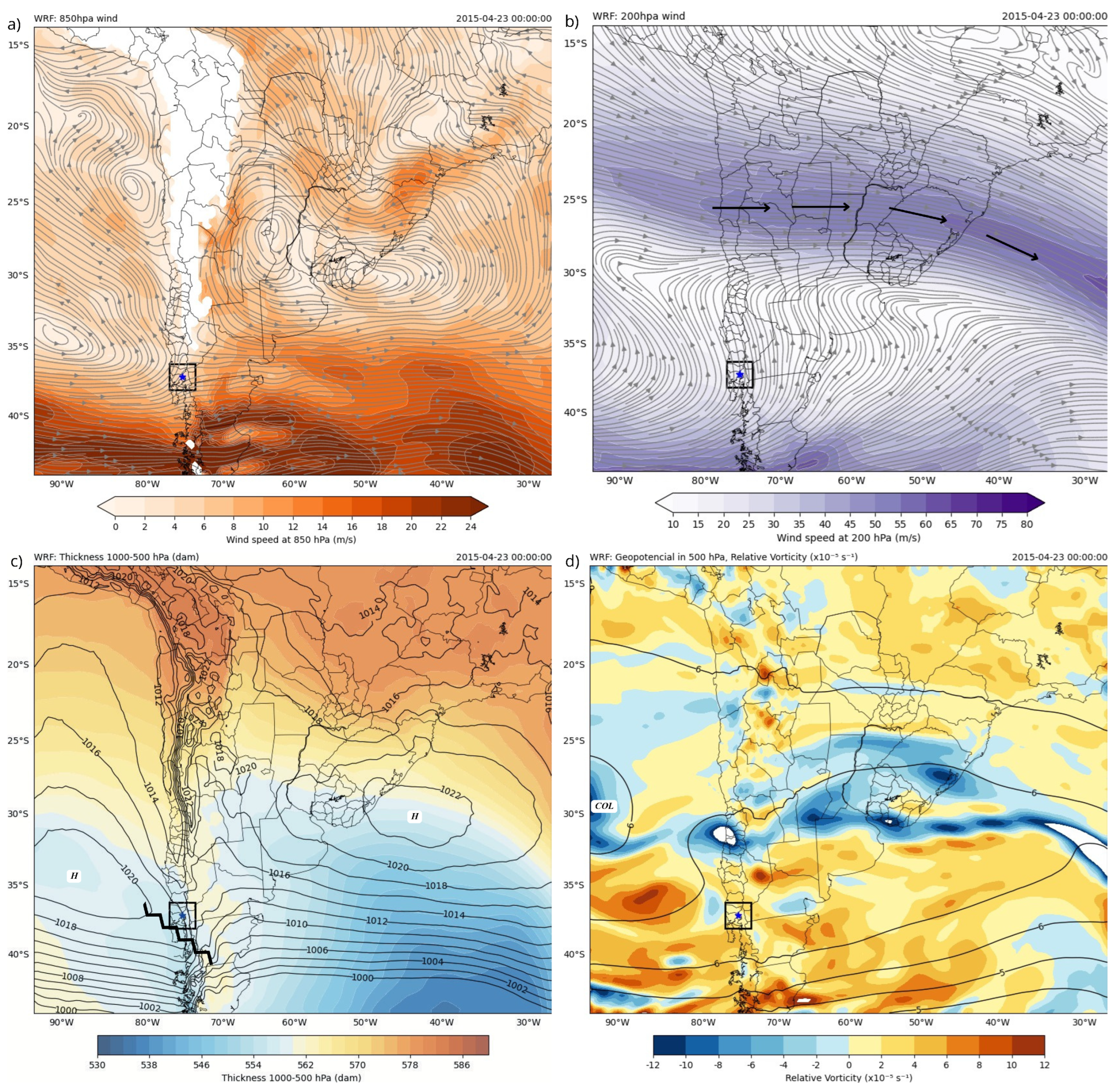
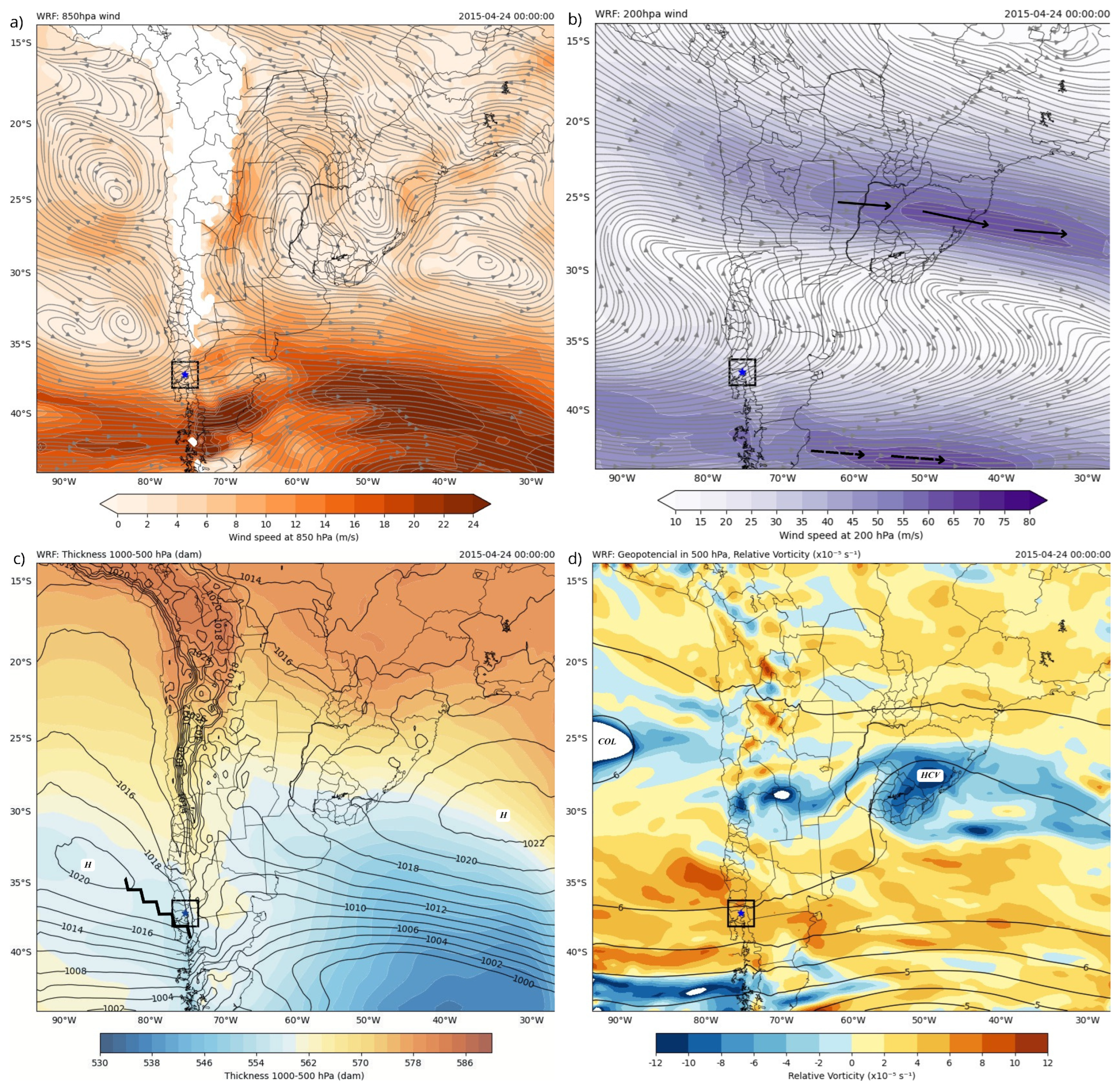
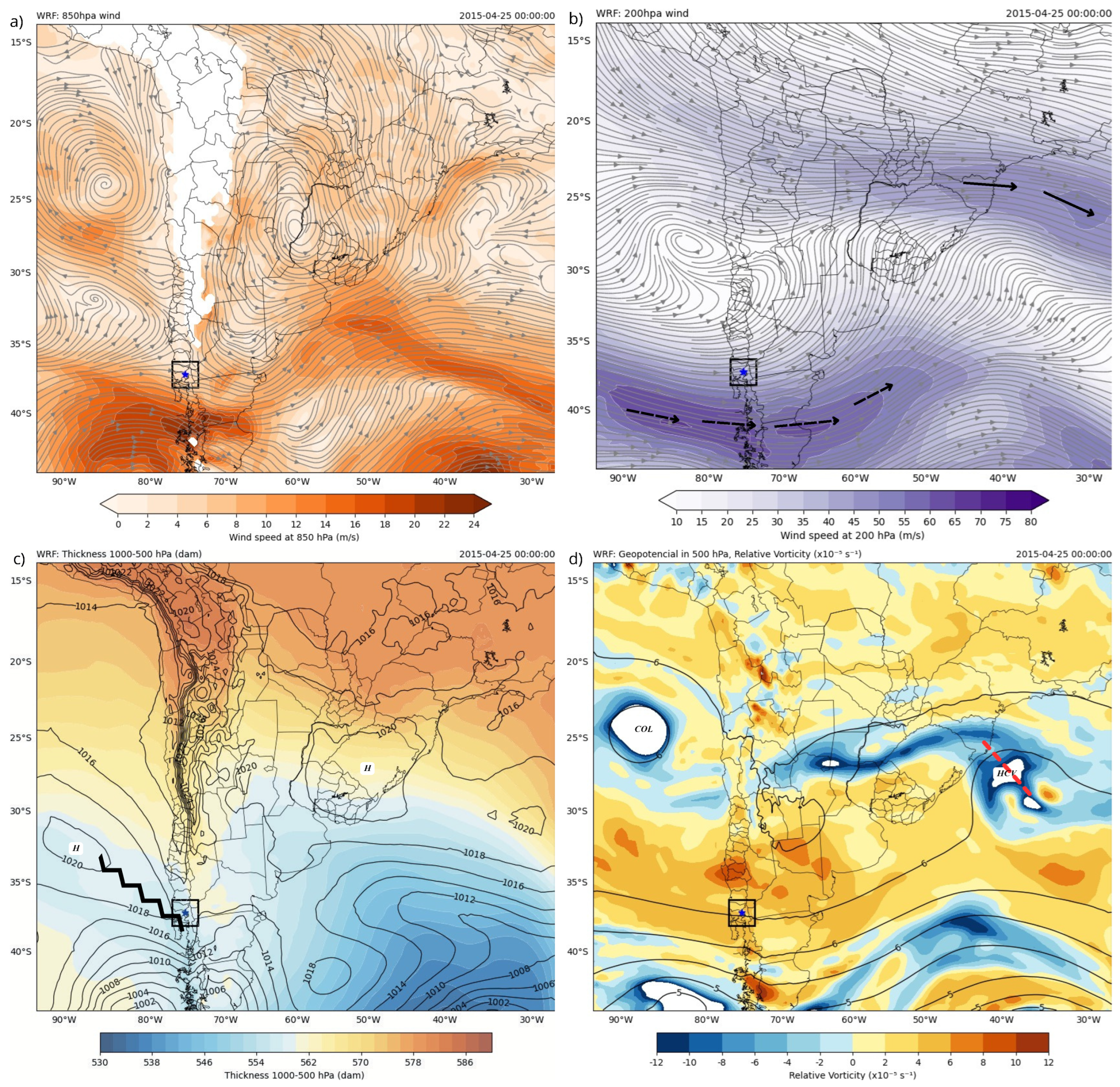

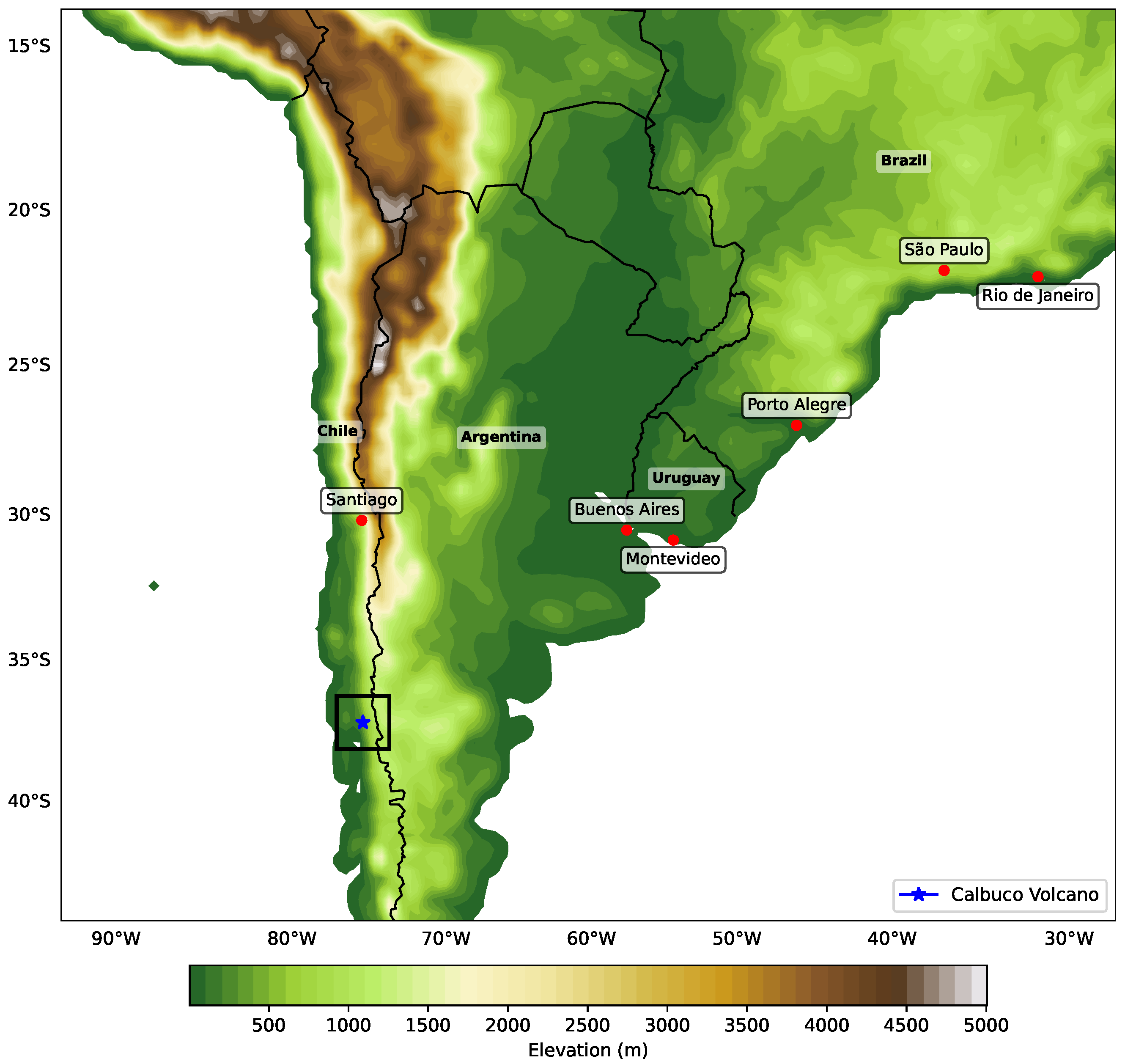
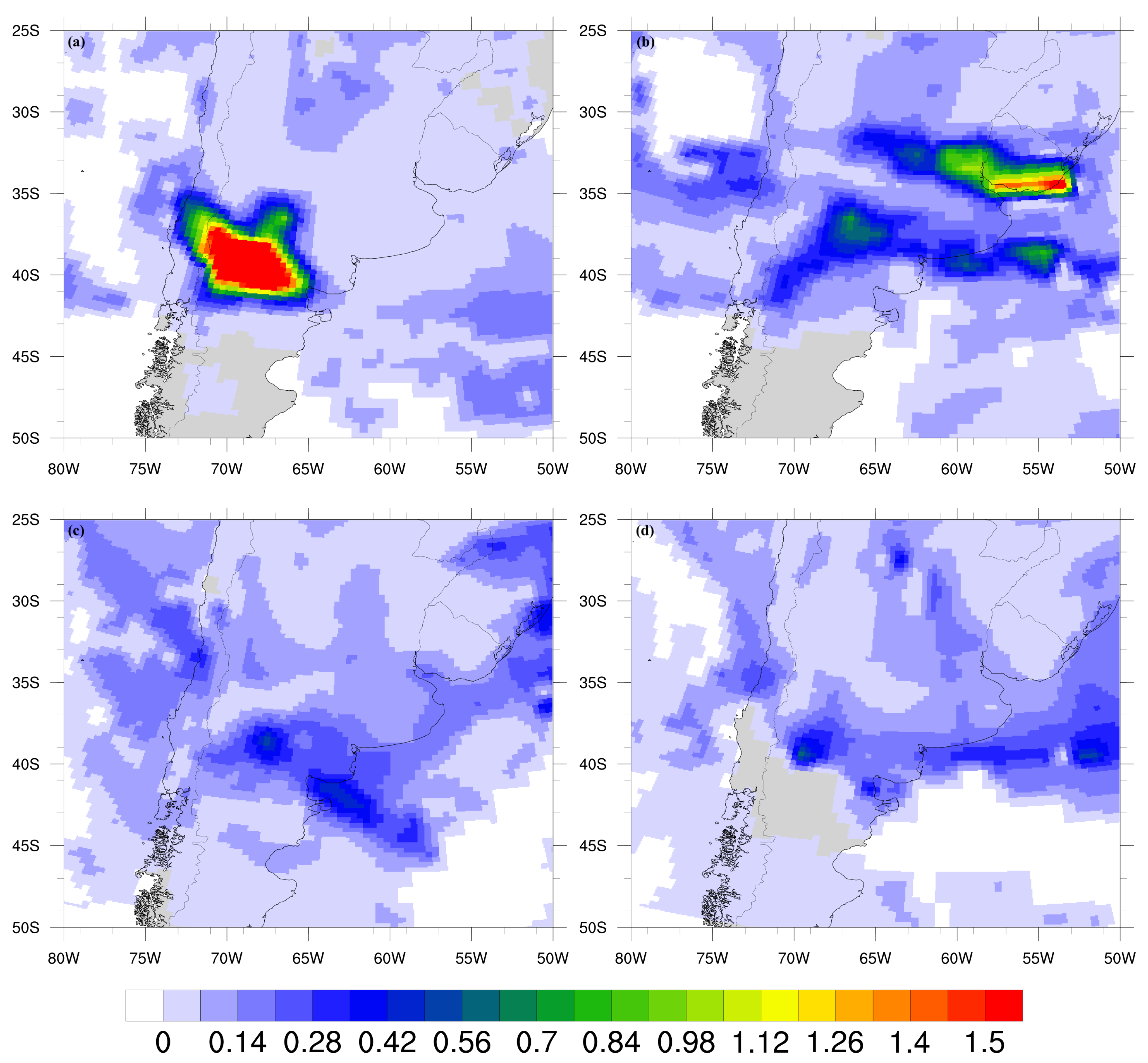
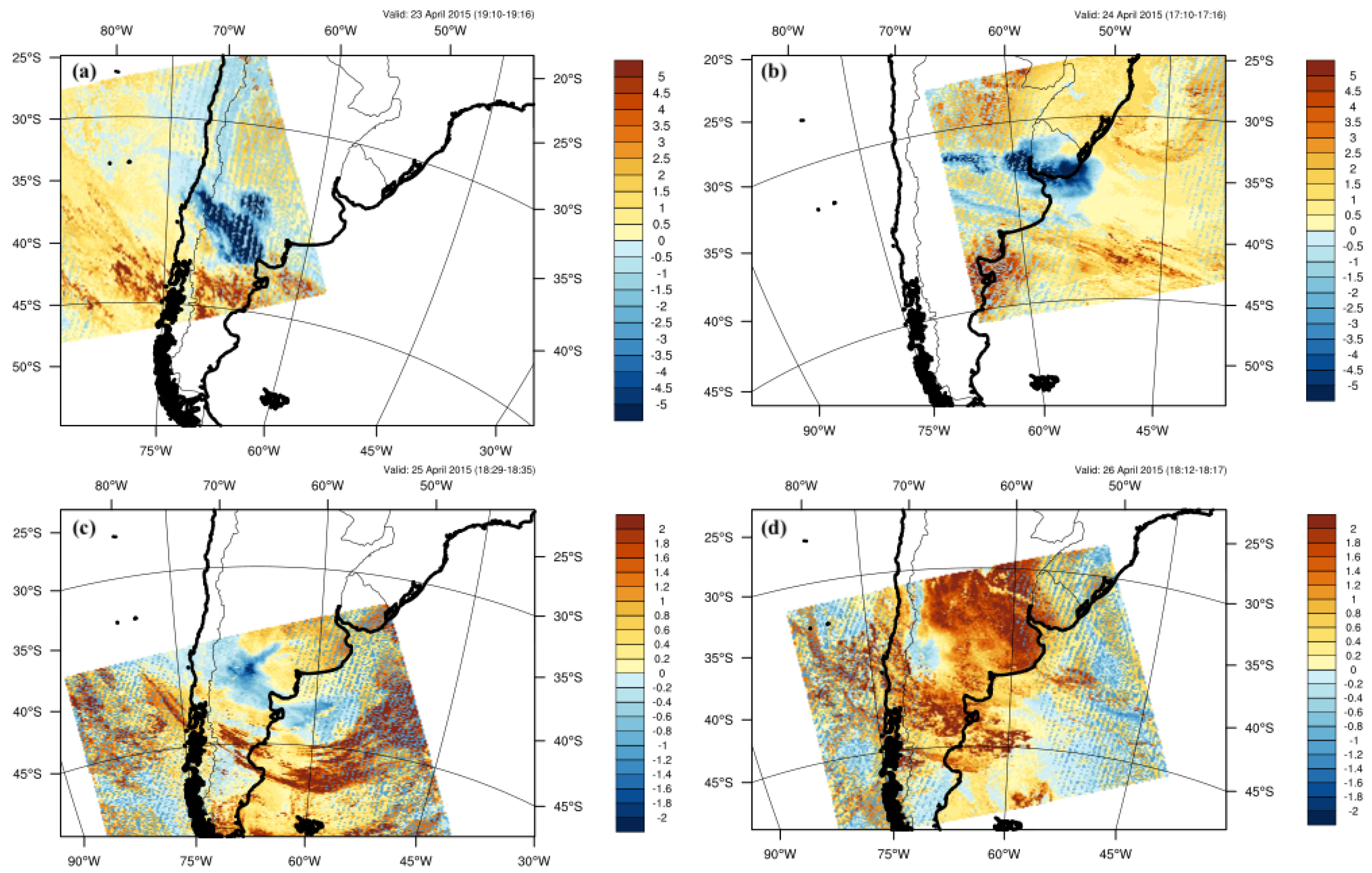
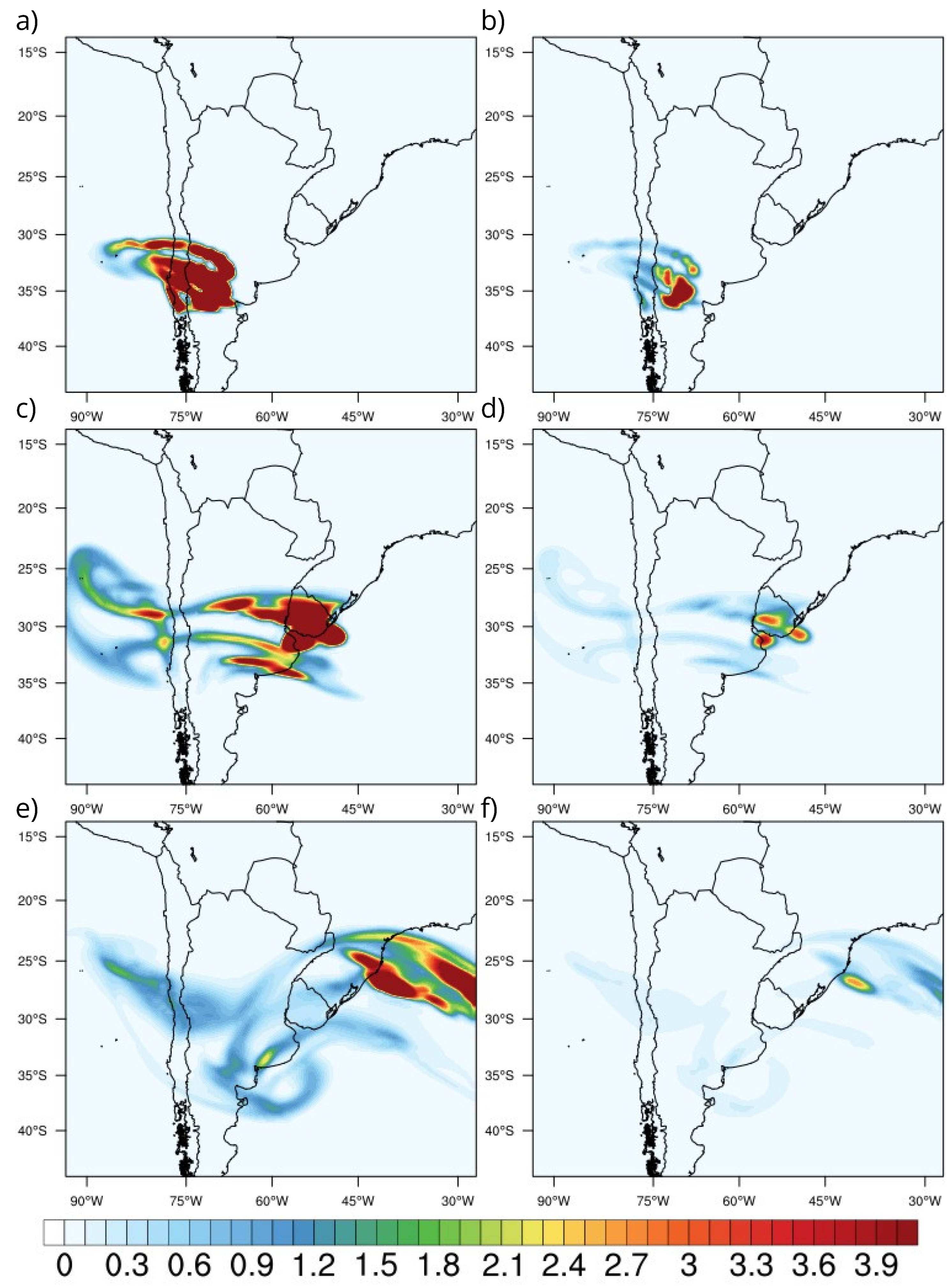
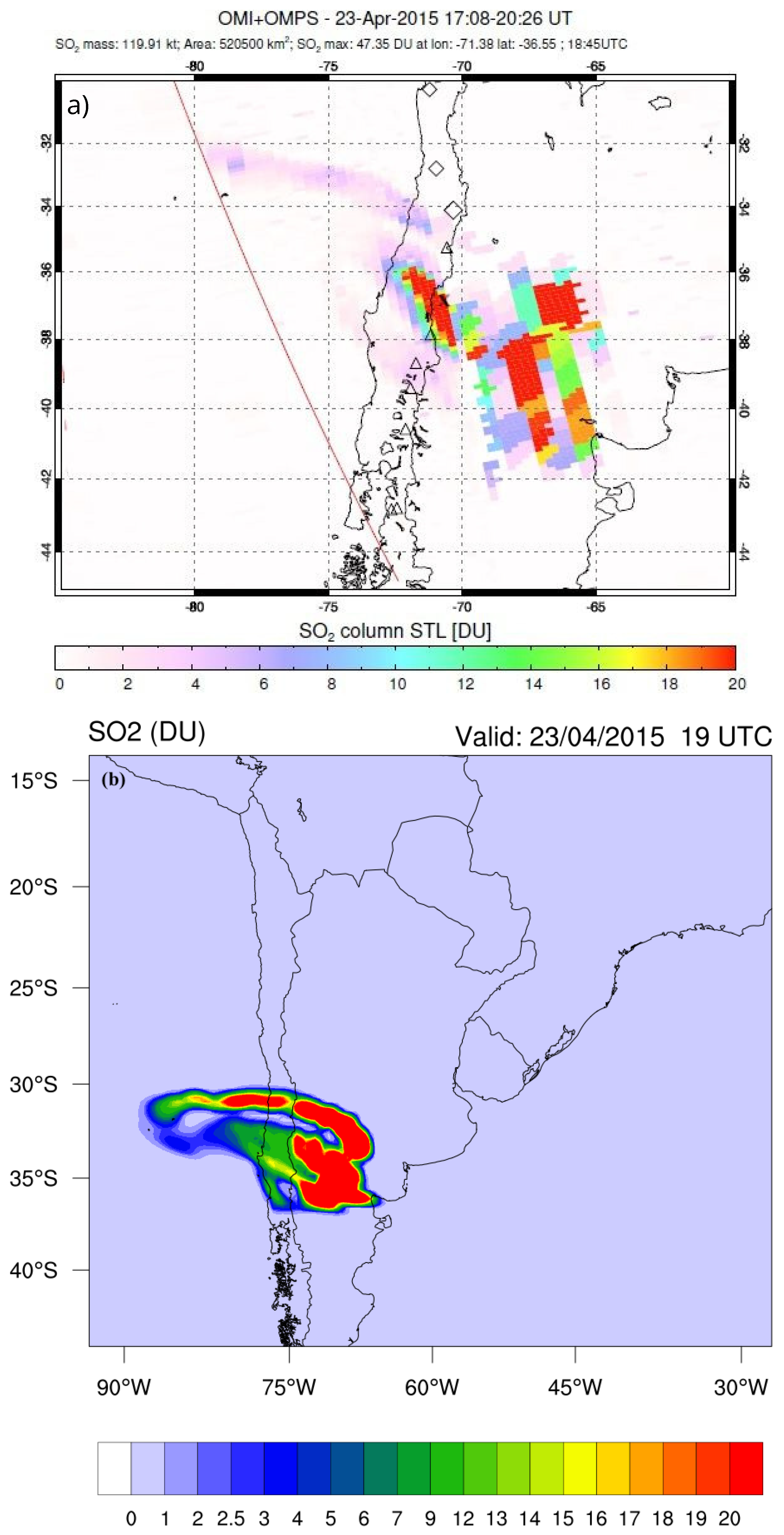
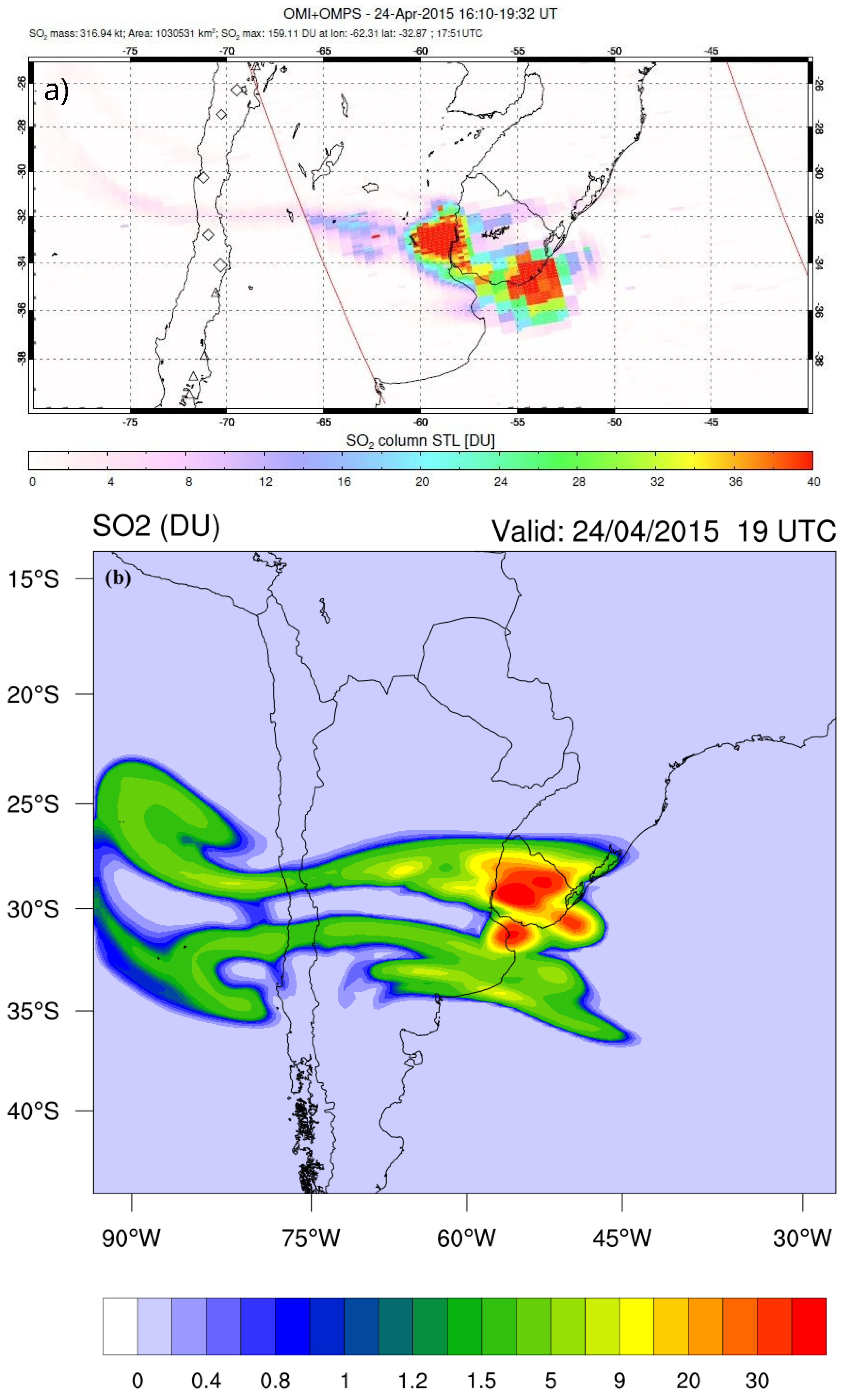
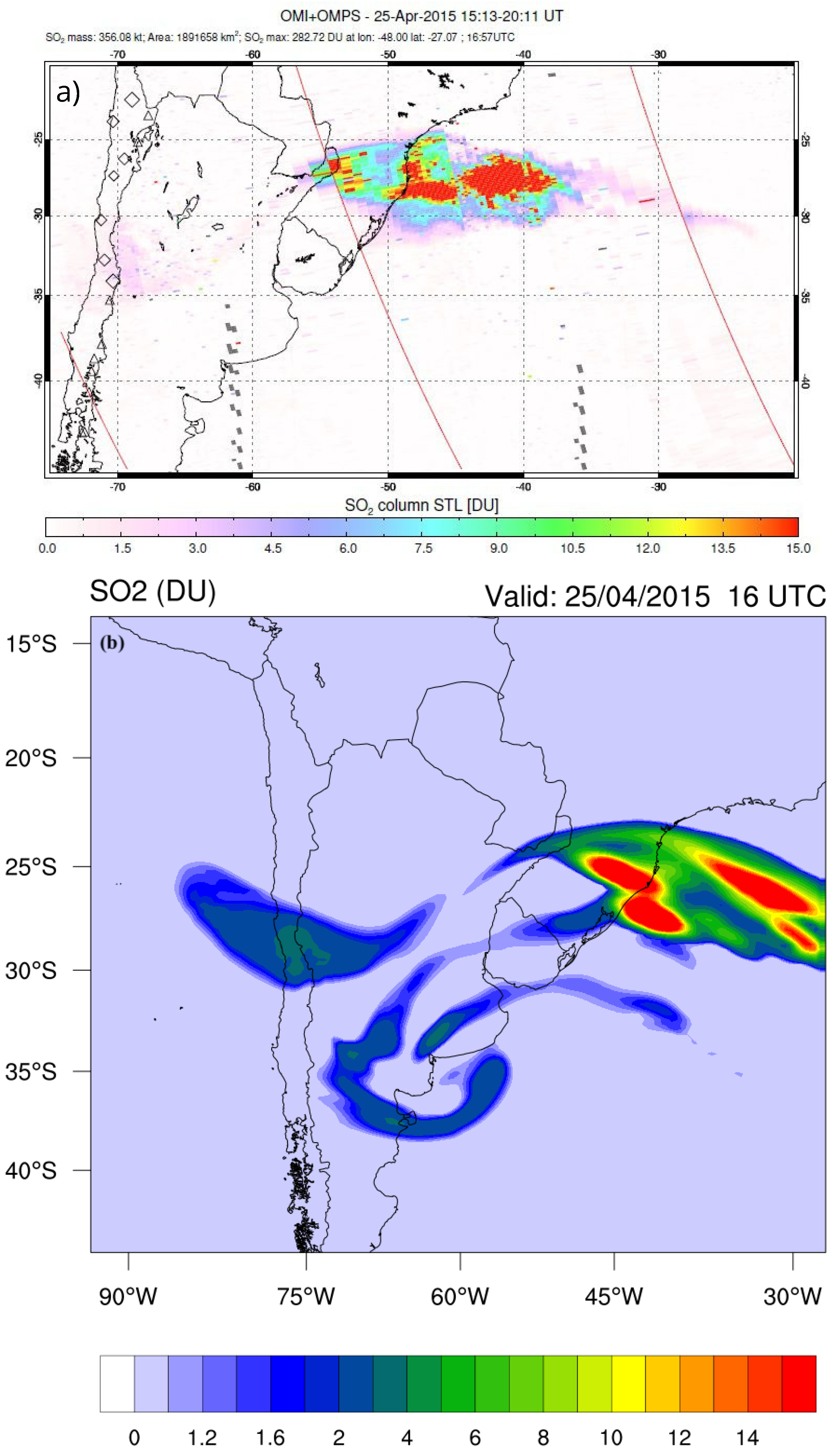
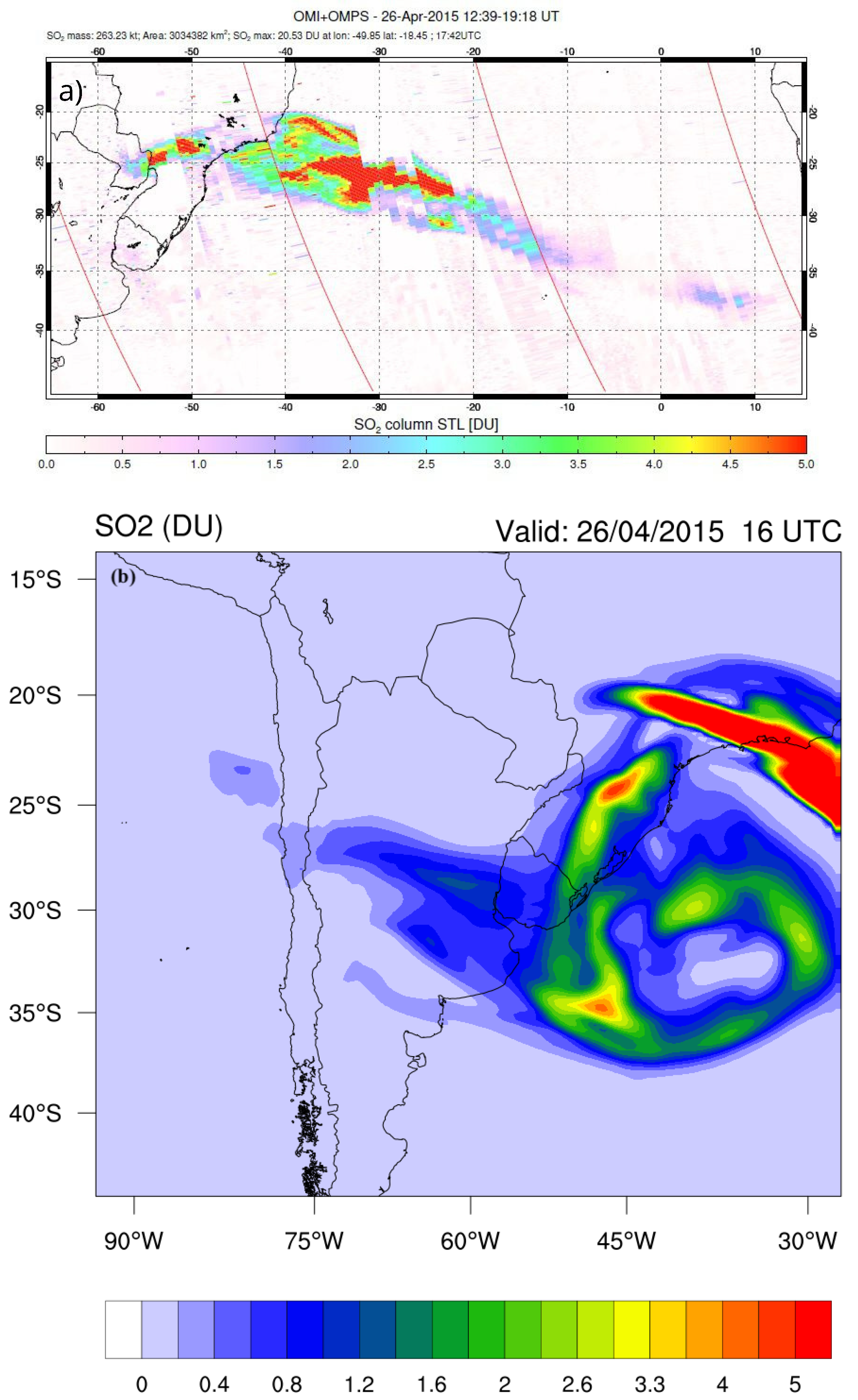
| Start Time | Durantion | Emiss Height | Emiss Ash Rate | Emiss SO2 |
|---|---|---|---|---|
| UTC | min | km | kg s−1 | kg h−1 |
| 22 April 2015—21:00 | 90 | 16 | ||
| 23 April 2015—04:00 | 360 | 17 |
| Var | Size Bins | S0 | S1 | S2 | S3 | S8 | S9 |
|---|---|---|---|---|---|---|---|
| vash_8 | 7.8125–15.625 µm | 8.0 | 1.3 | 8.0 | 15.0 | 15.0 | 18.0 |
| vash_9 | 3.9065–7.8125 µm | 5.0 | 0.6 | 5.0 | 10.0 | 10.0 | 7.0 |
| vash_10 | <3.9065 µm | 3.0 | 0.5 | 3.5 | 11.2 | 11.2 | 0.0 |
| Case | Chem_opt | Distribution | Vash_# | % Total Mass |
|---|---|---|---|---|
| GCTS2 | 300 | S2 | 8–10 | 16.5 |
| GCTS1 | 300 | S1 | 8–10 | 2.4 |
| Day | Granule Time |
|---|---|
| 23 | 19:10–19:16 |
| 24 | 17:10–17:16 |
| 25 | 18:29–18:36 |
| 26 | 18:12–18:17 |
Disclaimer/Publisher’s Note: The statements, opinions and data contained in all publications are solely those of the individual author(s) and contributor(s) and not of MDPI and/or the editor(s). MDPI and/or the editor(s) disclaim responsibility for any injury to people or property resulting from any ideas, methods, instructions or products referred to in the content. |
© 2024 by the authors. Licensee MDPI, Basel, Switzerland. This article is an open access article distributed under the terms and conditions of the Creative Commons Attribution (CC BY) license (https://creativecommons.org/licenses/by/4.0/).
Share and Cite
de Bem, D.L.; Anabor, V.; Puhales, F.S.; Pinheiro, D.K.; Grasso, F.; Steffenel, L.A.; Brenner, L.; Rizza, U. Investigating Synoptic Influences on Tropospheric Volcanic Ash Dispersion from the 2015 Calbuco Eruption Using WRF-Chem Simulations and Satellite Data. Remote Sens. 2024, 16, 4455. https://doi.org/10.3390/rs16234455
de Bem DL, Anabor V, Puhales FS, Pinheiro DK, Grasso F, Steffenel LA, Brenner L, Rizza U. Investigating Synoptic Influences on Tropospheric Volcanic Ash Dispersion from the 2015 Calbuco Eruption Using WRF-Chem Simulations and Satellite Data. Remote Sensing. 2024; 16(23):4455. https://doi.org/10.3390/rs16234455
Chicago/Turabian Stylede Bem, Douglas Lima, Vagner Anabor, Franciano Scremin Puhales, Damaris Kirsch Pinheiro, Fabio Grasso, Luiz Angelo Steffenel, Leonardo Brenner, and Umberto Rizza. 2024. "Investigating Synoptic Influences on Tropospheric Volcanic Ash Dispersion from the 2015 Calbuco Eruption Using WRF-Chem Simulations and Satellite Data" Remote Sensing 16, no. 23: 4455. https://doi.org/10.3390/rs16234455
APA Stylede Bem, D. L., Anabor, V., Puhales, F. S., Pinheiro, D. K., Grasso, F., Steffenel, L. A., Brenner, L., & Rizza, U. (2024). Investigating Synoptic Influences on Tropospheric Volcanic Ash Dispersion from the 2015 Calbuco Eruption Using WRF-Chem Simulations and Satellite Data. Remote Sensing, 16(23), 4455. https://doi.org/10.3390/rs16234455









